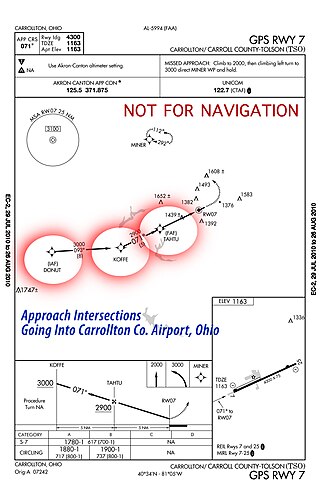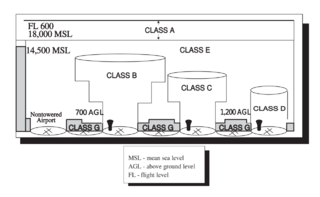Related Research Articles

In aviation, instrument flight rules (IFR) is one of two sets of regulations governing all aspects of civil aviation aircraft operations; the other is visual flight rules (VFR).
The Federal Aviation Regulations (FARs) are rules prescribed by the Federal Aviation Administration (FAA) governing all aviation activities in the United States. The FARs comprise Title 14 of the Code of Federal Regulations. A wide variety of activities are regulated, such as aircraft design and maintenance, typical airline flights, pilot training activities, hot-air ballooning, lighter-than-air aircraft, man-made structure heights, obstruction lighting and marking, model rocket launches, commercial space operations, model aircraft operations, Unmanned Aircraft Systems (UAS) and kite flying. The rules are designed to promote safe aviation, protecting pilots, flight attendants, passengers and the general public from unnecessary risk.
Mayday is an emergency procedure word used internationally as a distress signal in voice-procedure radio communications.

An airfield traffic pattern is a standard path followed by aircraft when taking off or landing while maintaining visual contact with the airfield.
Aviation is the design, development, production, operation, and use of aircraft, especially heavier-than-air aircraft. Articles related to aviation include:
Airspace is the portion of the atmosphere controlled by a country above its territory, including its territorial waters or, more generally, any specific three-dimensional portion of the atmosphere. It is not the same as outer space which is the expanse or space outside the Earth and aerospace which is the general term for Earth's atmosphere and the outer space within the planet's vicinity.
Automatic terminal information service, or ATIS, is a continuous broadcast of recorded aeronautical information in busier terminal areas. ATIS broadcasts contain essential information, such as current weather information, active runways, available approaches, and any other information required by the pilots, such as important NOTAMs. Pilots usually listen to an available ATIS broadcast before contacting the local control unit, which reduces the controllers' workload and relieves frequency congestion. ATIS was developed and adopted by the FAA in the mid-1960s and internationally beginning in 1974. Before the adoption of ATIS, this information was routinely disseminated to each aircraft separately, increasing controller workload during periods of high traffic density.
Radiotelephony procedure includes various techniques used to clarify, simplify and standardize spoken communications over two-way radios, in use by the armed forces, in civil aviation, police and fire dispatching systems, citizens' band radio (CB), and amateur radio.
The Air Commerce Act of 1926 created an Aeronautic Branch of the United States Department of Commerce. Its functions included testing and licensing of pilots, certification of aircraft and investigation of accidents.

In aviation, an intersection is a virtual navigational fix that helps aircraft maintain their flight plan. It is usually defined as the intersection of two VOR radials. They are usually identified as major airway intersections where aircraft, operating under instrument flight rules, often change direction of flight while en route. According to the Federal Aviation Regulations, some intersections are designated as mandatory reporting points for pilots who are not in radar contact with air traffic control.

In the United States, airways or air routes are defined by the Federal Aviation Administration (FAA) in two ways:
In United States and Canadian aviation, the Aeronautical Information Manual (AIM) is the respective nation's official guide to basic flight information and air traffic control procedures.
A UNICOM station is an air-ground communication facility operated by a non-air traffic control private agency to provide advisory service at uncontrolled aerodromes and airports and to provide various non-flight services, such as requesting a taxi, even at towered airports. It is also known as an aeronautical advisory station, with these terms being used mostly in the Americas. The equivalent European/ICAO service is known as (aerodrome) flight information service, abbreviated as AFIS or FIS. From an ICAO perspective, UNICOM, historically most commonly provided by flight service stations, is an implementation of FIS.

In aviation, a non-towered airport is an airport without a control tower, or air traffic control (ATC) unit. The vast majority of the world's airports are non-towered. In the United States, there are close to 20,000 non-towered airports compared to approximately 500 airports with control towers. Airports with a control tower without 24/7 ATC service follow non-towered airport procedures when the tower is closed but the airport remains open, for example at night.

The United States airspace system's classification scheme is intended to maximize pilot flexibility within acceptable levels of risk appropriate to the type of operation and traffic density within that class of airspace – in particular to provide separation and active control in areas of dense or high-speed flight operations.

Landing lights are lights, mounted on aircraft, that illuminate the terrain and runway ahead during takeoff and landing, as well as being used as a collision avoidance measure against other aircraft and bird strikes. Landing lights must be activated when the aircraft is under 10,000 feet in altitude.

In aviation, V-speeds are standard terms used to define airspeeds important or useful to the operation of all aircraft. These speeds are derived from data obtained by aircraft designers and manufacturers during flight testing for aircraft type-certification. Using them is considered a best practice to maximize aviation safety, aircraft performance, or both.
A contact approach is an approach available to aircraft operating on an instrument flight rules (IFR) flight plan, where the pilot may deviate from the published instrument approach procedure (IAP) and proceed to the destination airport by visual reference to the surface. It is similar to a visual approach, except that the pilot is not required to have the destination airport nor the preceding aircraft in sight at all times during the approach, and the visibility requirements are less stringent.
FAA Order JO 7110.65 is an FAA directive that prescribes air traffic control (ATC) procedures and phraseology for use by personnel providing ATC services in the USA. The current version and subsequent lettered versions are published according to the publication schedule contained within the order, usually every 6 months. The latest version is 7110.65AA.
References
- ↑ Kitty Campbell Laird (2006). Pedagogical Approaches to Aviation Phraseology and Communication Training in Collegiate Flight Programs. ProQuest. pp. 11–. ISBN 978-0-542-86484-1.
- ↑ Eduardo Salas; Florian Jentsch; Dan Maurino (30 January 2010). Human Factors in Aviation. Academic Press. pp. 642–. ISBN 978-0-08-092302-4.
- 1 2 Federal Aviation Administration (1 November 2012). Federal Aviation Regulations/Aeronautical Information Manual 2013. Skyhorse Publishing Inc. pp. 583–. ISBN 978-1-61608-834-7.
- ↑ Francisco Xavier Almeida (1978). Structures in Aeronautical Phraseology: From English to Spanish. University of Wisconsin--Madison.
- ↑ Federal Aviation Administration (FAA) (November 2008). Federal Aviation Regulations/Aeronautical Information Manual. Skyhorse Publishing Inc. pp. 92–. ISBN 978-1-60239-298-4.
- ↑ Christoph Schubert; Christina Sanchez-Stockhammer (24 May 2016). Variational Text Linguistics: Revisiting Register in English. De Gruyter. pp. 80–. ISBN 978-3-11-044355-4.
- ↑ Michael S. Nolan (1 May 2015). A Career in Air Traffic Control. eAcademicBooks LLC. pp. 87–. ISBN 978-0-9962452-0-3.
- ↑ United States Army Aviation Digest. U.S. Army Aviation Center. 1983.